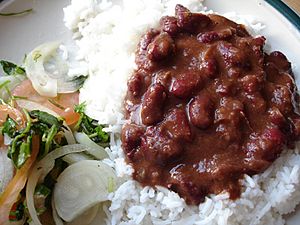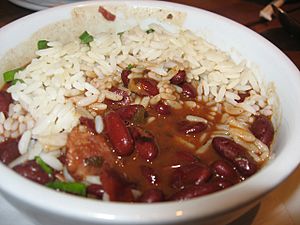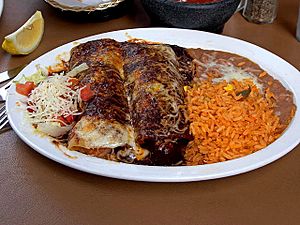Rice and beans facts for kids

Rice and brown beans served in a hotel in the southeast Brazilian countryside. The dish may be accompanied by meat, bread, eggs, vegetables, etc.
|
|
| Course | Breakfast, lunch, dinner |
|---|---|
| Region or state | Worldwide |
| Main ingredients | Rice, beans |
| Variations | Regional variations |
Rice and beans is a popular meal found in many cultures around the world. It combines two important foods: rice and beans. This mix gives you lots of nutrients and energy. Both rice and beans are easy to find and grow.
Usually, the beans are seasoned with different spices, while the rice can be plain or also seasoned. Sometimes, the rice and beans are mixed together on the plate. Other times, they are served side by side.
Contents
What are Beans and Rice?

This dish usually has white or brown rice. It comes with cooked dry beans, which can be brown, red, or black. These beans are often from the Phaseolus vulgaris or Vigna unguiculata plant. They are seasoned in many different ways.
People often eat beans and rice with other foods like stewed chicken, pork, beef, or potato salad. In many places, the beans and rice are served next to each other instead of mixed. This meal can be eaten on its own, or with a topping of meat or chicken. Sometimes, meat or other ingredients are put on top of the beans and rice, or even mixed in.
Different places have their own favorite ways to make this dish. For example, in Brazil, black beans are very popular in some states like Rio de Janeiro. But in other parts of Brazil, black beans are mostly used for a special dish called feijoada. In New Orleans, USA, a dish called "red beans and rice" is often served with smoked sausage or a fried pork chop.
How Did Beans and Rice Become Popular?
Early History in the Americas
Scientists have studied the common bean plant and found that it first grew in Central America (Mesoamerica). From there, it spread south. It was often grown with maize (corn) and squash, which are plants that grow well together.
Asian rice was brought to Mexico and Brazil by the Spanish and Portuguese during the time of colonization. However, people have recently found that native groups in the Amazon region were already growing a type of wild rice, related to Asian rice, about 4,000 years ago! They grew it alongside corn and squash, just like beans. Some historians also believe that enslaved Africans played a big part in bringing rice to the Americas. Today, beans and rice are a very common food in many Spanish-speaking countries.
Why Are Beans and Rice Good for You?
Beans and rice are both healthy foods. Rice gives you lots of starch, which is a great source of energy for your body. Rice also has iron and some protein. Beans also have iron and even more protein than rice.
When you eat beans and rice together, they form a "complete protein". This means they give your body all the important building blocks (called amino acids) that your body can't make by itself. So, it's a very nutritious meal!
Beans and Rice in Culture
In many Latin American countries, beans and rice are eaten almost every day for lunch. They are often served with different kinds of meats and vegetables. It's also common to use leftovers from lunch to make dinner.
Beans and rice are especially popular in Brazil. Brazil is one of the biggest producers of dry beans in the world and the largest consumer of rice in the Americas. This shows how important this dish is to their culture.
Different Beans and Rice Dishes Around the World
There are many different dishes around the world that use beans and rice as their main ingredients. The way they are cooked and what else is added can change a lot from one place to another. Each culture adds its own special touch!
In countries near the Caribbean Sea, these dishes are often called rice and beans. They are usually cooked with coconut milk. Here are some examples of different beans and rice dishes:
- Brazil: arroz com feijão or feijoada. Feijoada is a traditional dish made with black beans and pork meat, served with rice.
- Chile: arroz con porotos.
- Caribbean: rice and peas
- China: Hóngdòu fàn, Laba congee
- Colombia: calentao
- Archipelago of San Andrés, Providencia and Santa Catalina: rice and beans
- Bandeja paisa: a traditional dish with kidney beans and rice.
- Costa Rica: gallo pinto. In the Caribbean parts of Costa Rica, rice and beans is cooked with coconut milk and a spicy habanero chili.
- Cuba: There are two main types:
- Moros y cristianos: also called moros, made with black beans.
- Congris: made with red beans. The beans are cooked with onion, garlic, and spices, then raw rice is added to cook together until dry.
- Dominican Republic:
- Moro de guandules: rice, pigeon peas, and vegetables cooked in one pot, sometimes with coconut milk.
- arroz con habichuelas: red beans stewed with squash, cilantro, and spices, served with rice.
- El Salvador: Casamiento. This dish is very common even though El Salvador doesn't have a Caribbean coast.
- Ghana: Waakye, a Ghanaian beans and rice dish.
- Guatemala: casado. In some areas, it's known as gallo pinto or rice and beans.
- On the Caribbean coast of Guatemala: it's called rice and beans and includes coconut milk.
- Honduras: Casamiento. On the Caribbean coast, it's known as rice and beans and includes coconut milk and chili flakes.
- India: Rajma chawal, an Indian red bean dish served with rice.
- Israel: Orez shu'it, a traditional Israeli beans and rice dish.
- Japan: Okowa, especially sekihan, which uses azuki beans and sticky rice.
- Jamaica: rice and peas.
- Korea: Kongbap (bean rice), patbap (red bean rice).
- Mexico: rice and beans.
- Nicaragua: gallo pinto. On the Caribbean Coast, it's called "rice and beans" and is made with coconut milk.
- Panama: gallopinto.
- Caribbean coast of Panama: known as rice and beans, prepared with coconut milk.
- Peru: Two main types:
- calentado
- tacu-tacu
- Puerto Rico:
- arroz junto: made with red, pink, or pinto beans and meat, all cooked in one pot.
- arroz con gandules: a one-pot dish with rice, pigeon peas, smoked pork, and other ingredients. This is part of Puerto Rico's national dish.
- arroz con habichuelas: white rice with stewed beans. The beans are usually stewed with potatoes, squash, ham, and tomato sauce.
- Suriname: bruine bonen met rijst, a one-pot dish with mixed meats and kidney beans, served with rice.
- Trinidad and Tobago: rice and peas.
- Turkey: national dish, kuru fasulya with dried beans.
- United States:
- Hoppin' John: a black-eyed peas dish from the southern United States.
- Red beans and rice: the most common beans and rice dish in Louisiana Creole cuisine.
- Venezuela: These dishes often include fried plantains called "tajadas":
- Pabellón criollo: Made with rice, black beans (or refried black beans), and seasoned shredded beef. It's often served with fried plantain slices.
- Arroz con caraotas: This is like Pabellón Criollo but without the fried plantains. It's sometimes called "poor man's lunch" but anyone can enjoy it. Fried eggs can also be added.
- Palo A pique llanero: Made with rice, brown beans, and seasoned shredded beef, chicken, and pork. It's served with fried plantain slices and potatoes.
- Liberia: In West Africa, beans are often cooked separately from rice. Kidney beans can be eaten as a soup on top of rice for special events.
Other Names for Beans and Rice
This dish has many names in different languages:
- In Spanish: arroz y habas, arroz con habichuelas, arroz con frijoles, gallo pinto, or recalentao.
- In Portuguese: arroz e feijão, arroz com feijão, or feijão com arroz.
- In Venetian language: risi e bisi.
- In Haitian Creole: diri ak pwa.
- In Judaeo-Spanish: avas kon arroz or avikas kon arroz.
See also
 In Spanish: Arroz con frijoles para niños
In Spanish: Arroz con frijoles para niños



